Validation and Analysis of MAIAC AOD Aerosol Products in East Asia from 2011 to 2020
Abstract
:1. Introduction
2. Data and Methods
2.1. Study Area
2.2. Data
2.2.1. MAIAC AOD
2.2.2. Ground-Based AOD
2.2.3. Auxiliary Data
2.3. Evaluation Methods
- (1)
- Pearson correlation coefficient (R)
- (2)
- Relative Mean Deviation (RMB)
- (3)
- Mean Absolute Error (MAE)
- (4)
- Root Mean Square Error (RMSE)
3. Results
3.1. Overall Comparison between MAIAC and AERONET AOD at 550 nm
3.2. Comparison of MAIAC and AERONET AOD at 550 nm in Different Seasons
3.3. Comparison of MAIAC and AERONET 550 nm AOD at Different Elevations
3.4. Comparison of MAIAC and AERONET 550 nm AOD in Different Climate Zones
3.5. Spatial Patterns of MAIAC AOD
4. Discussion
5. Conclusions
Author Contributions
Funding
Data Availability Statement
Acknowledgments
Conflicts of Interest
References
- Xie, Z.Y.; Liu, H.; Tang, X.M. Correlation analysis between MODIS aerosol optical depth and PM10 concentration over Beijing. Acta Sci. Circumst. 2015, 35, 3292–3299. [Google Scholar] [CrossRef]
- Luo, R.; Liu, Y.; Zhu, Q.; Tang, Y.; Shao, T. Effects of aerosols on cloud and precipitation in East-Asian drylands. Int. J. Climatol. 2021, 41, 4603–4618. [Google Scholar] [CrossRef]
- Kuniyal, J.C.; Guleria, R.P. The current state of aerosol-radiation interactions: A mini review. J. Aerosol Sci. 2019, 130, 45–54. [Google Scholar] [CrossRef]
- Pan, Y.-L.; Kalume, A.; Wang, C.; Santarpia, J. Atmospheric aging processes of bioaerosols under laboratory-controlled conditions: A review. J. Aerosol Sci. 2021, 155, 105767. [Google Scholar] [CrossRef]
- Devara, P.C.S.; Vijayakumar, K.; Safai, P.D. Multi-spectral nephelometer characterization of urban aerosols. Measurement 2020, 154, 107471. [Google Scholar] [CrossRef]
- Bzdek, B.R.; DePalma, J.W.; Johnston, M.V. Mechanisms of Atmospherically Relevant Cluster Growth. Acc. Chem. Res. 2017, 50, 1965–1975. [Google Scholar] [CrossRef] [PubMed]
- Su, H.; Cheng, Y.; Poschl, U. New Multiphase Chemical Processes Influencing Atmospheric Aerosols, Air Quality, and Climate in the Anthropocene. Acc. Chem. Res. 2020, 53, 2034–2043. [Google Scholar] [CrossRef]
- Bluvshtein, N.; Flores, J.M.; Segev, L.; Rudich, Y. A new approach for retrieving the UV–vis optical properties of ambient aerosols. Atmos. Meas. Tech. 2016, 9, 3477–3490. [Google Scholar] [CrossRef] [Green Version]
- Singh, T.; Khillare, P.S.; Shridhar, V.; Agarwal, T. Visibility impairing aerosols in the urban atmosphere of Delhi. Environ. Monit. Assess. 2008, 141, 67–77. [Google Scholar] [CrossRef]
- Wu, Z.; Chen, J.; Wang, Y.; Zhu, Y.; Liu, Y.; Yao, B.; Zhang, Y.; Hu, M. Interactions between water vapor and atmospheric aerosols have key roles in air quality and climate change. Natl. Sci. Rev. 2018, 5, 452–454. [Google Scholar] [CrossRef]
- Zhao, X.; Allen, R.J.; Thomson, E.S. An Implicit Air Quality Bias Due to the State of Pristine Aerosol. Earth’s Future 2021, 9, e2021EF001979. [Google Scholar] [CrossRef]
- Lelieveld, J.; Evans, J.S.; Fnais, M.; Giannadaki, D.; Pozzer, A. The contribution of outdoor air pollution sources to premature mortality on a global scale. Nature 2015, 525, 367–371. [Google Scholar] [CrossRef]
- Ouyang, R.; Yang, S.; Xu, L. Analysis and Risk Assessment of PM2.5-Bound PAHs in a Comparison of Indoor and Outdoor Environments in a Middle School: A Case Study in Beijing, China. Atmosphere 2020, 11, 904. [Google Scholar] [CrossRef]
- Wang, Y.; Yuan, Q.; Li, T.; Shen, H.; Zheng, L.; Zhang, L. Large-scale MODIS AOD products recovery: Spatial-temporal hybrid fusion considering aerosol variation mitigation. ISPRS J. Photogramm. Remote Sens. 2019, 157, 1–12. [Google Scholar] [CrossRef]
- Pan, X.; Uno, I.; Hara, Y.; Osada, K.; Yamamoto, S.; Wang, Z.; Sugimoto, N.; Kobayashi, H.; Wang, Z. Polarization properties of aerosol particles over western Japan: Classification, seasonal variation, and implications for air quality. Atmos. Chem. Phys. 2016, 16, 9863–9873. [Google Scholar] [CrossRef] [Green Version]
- Stachlewska, I.; Zawadzka, O.; Engelmann, R. Effect of Heat Wave Conditions on Aerosol Optical Properties Derived from Satellite and Ground-Based Remote Sensing over Poland. Remote Sens. 2017, 9, 1199. [Google Scholar] [CrossRef] [Green Version]
- Levy, R.C.; Mattoo, S.; Sawyer, V.; Shi, Y.; Colarco, P.R.; Lyapustin, A.I.; Wang, Y.; Remer, L.A. Exploring systematic offsets between aerosol products from the two MODIS sensors. Atmos. Meas. Tech. 2018, 11, 4073–4092. [Google Scholar] [CrossRef] [PubMed] [Green Version]
- Bright, J.M.; Gueymard, C.A. Climate-specific and global validation of MODIS Aqua and Terra aerosol optical depth at 452 AERONET stations. Sol. Energy 2019, 183, 594–605. [Google Scholar] [CrossRef]
- Korras-Carraca, M.B.; Hatzianastassiou, N.; Matsoukas, C.; Gkikas, A.; Papadimas, C.D. The regime of aerosol asymmetry parameter over Europe, the Mediterranean and the Middle East based on MODIS satellite data: Evaluation against surface AERONET measurements. Atmos. Chem. Phys. 2015, 15, 13113–13132. [Google Scholar] [CrossRef] [Green Version]
- Che, H.; Yang, L.; Liu, C.; Xia, X.; Wang, Y.; Wang, H.; Wang, H.; Lu, X.; Zhang, X. Long-term validation of MODIS C6 and C6.1 Dark Target aerosol products over China using CARSNET and AERONET. Chemosphere 2019, 236, 124268. [Google Scholar] [CrossRef] [PubMed]
- Aldabash, M.; Bektas Balcik, F.; Glantz, P. Validation of MODIS C6.1 and MERRA-2 AOD Using AERONET Observations: A Comparative Study over Turkey. Atmosphere 2020, 11, 905. [Google Scholar] [CrossRef]
- Anoruo, C.M. Monsoon-seasonal validation of MODIS aerosol optical depth and characterization using AERONET observation retrieve over Italy. Environ. Res. 2022, 204, 111985. [Google Scholar] [CrossRef] [PubMed]
- Lyapustin, A.; Wang, Y.; Korkin, S.; Huang, D. MODIS Collection 6 MAIAC algorithm. Atmos. Meas. Tech. 2018, 11, 5741–5765. [Google Scholar] [CrossRef] [Green Version]
- Martins, V.S.; Lyapustin, A.; de Carvalho, L.A.; Barbosa, C.C.F.; Novo, E.M.L.D.M. Validation of high-resolution MAIAC aerosol product over South America. J. Geophys. Res. Atmos. 2017, 122, 7537–7559. [Google Scholar] [CrossRef]
- Mhawish, A.; Banerjee, T.; Sorek-Hamer, M.; Lyapustin, A.; Broday, D.M.; Chatfield, R. Comparison and evaluation of MODIS Multi-angle Implementation of Atmospheric Correction (MAIAC) aerosol product over South Asia. Remote Sens. Environ. 2019, 224, 12–28. [Google Scholar] [CrossRef]
- Stafoggia, M.; Schwartz, J.; Badaloni, C.; Bellander, T.; Alessandrini, E.; Cattani, G.; De’ Donato, F.; Gaeta, A.; Leone, G.; Lyapustin, A.; et al. Estimation of daily PM10 concentrations in Italy (2006–2012) using finely resolved satellite data, land use variables and meteorology. Environ. Int. 2017, 99, 234–244. [Google Scholar] [CrossRef] [PubMed]
- Zhdanova, E.Y.; Chubarova, N.Y.; Lyapustin, A.I. Assessment of urban aerosol pollution over the Moscow megacity by the MAIAC aerosol product. Atmos. Meas. Tech. 2020, 13, 877–891. [Google Scholar] [CrossRef] [Green Version]
- Chen, X.; Ding, J.; Liu, J.; Wang, J.; Ge, X.; Wang, R.; Zuo, H. Validation and comparison of high-resolution MAIAC aerosol products over Central Asia. Atmos. Environ. 2021, 251, 118273. [Google Scholar] [CrossRef]
- Falah, S.; Mhawish, A.; Sorek-Hamer, M.; Lyapustin, A.I.; Kloog, I.; Banerjee, T.; Kizel, F.; Broday, D.M. Impact of environmental attributes on the uncertainty in MAIAC/MODIS AOD retrievals: A comparative analysis. Atmos. Environ. 2021, 262, 118659. [Google Scholar] [CrossRef]
- Wu, Z.; Zhao, H.; Hao, J.; Wu, G. Climatological Characteristics and Aerosol Loading Trends from 2001 to 2020 Based on MODIS MAIAC Data for Tianjin, North China Plain. Sustainability 2022, 14, 1072. [Google Scholar] [CrossRef]
- Jethva, H.; Torres, O.; Yoshida, Y. Accuracy assessment of MODIS land aerosol optical thickness algorithms using AERONET measurements over North America. Atmos. Meas. Tech. 2019, 12, 4291–4307. [Google Scholar] [CrossRef] [Green Version]
- Yang, M.; Howell, S.G.; Zhuang, J.; Huebert, B.J. Attribution of aerosol light absorption to black carbon, brown carbon, and dust in China—Interpretations of atmospheric measurements during EAST-AIRE. Atmos. Chem. Phys. 2009, 9, 2035–2050. [Google Scholar] [CrossRef] [Green Version]
- Krishnan, R.; Ramanathan, V. Evidence of surface cooling from absorbing aerosols. Geophys. Res. Lett. 2002, 29, 54-1–54-4. [Google Scholar] [CrossRef] [Green Version]
- Li, C.; McLinden, C.; Fioletov, V.; Krotkov, N.; Carn, S.; Joiner, J.; Streets, D.; He, H.; Ren, X.; Li, Z.; et al. India Is Overtaking China as the World’s Largest Emitter of Anthropogenic Sulfur Dioxide. Sci. Rep. 2017, 7, 14304. [Google Scholar] [CrossRef] [PubMed] [Green Version]
- Myhre, G.; Aas, W.; Cherian, R.; Collins, W.; Faluvegi, G.; Flanner, M.; Forster, P.; Hodnebrog, Ø.; Klimont, Z.; Lund, M.T.; et al. Multi-model simulations of aerosol and ozone radiative forcing due to anthropogenic emission changes during the period 1990–2015. Atmos. Chem. Phys. 2017, 17, 2709–2720. [Google Scholar] [CrossRef] [Green Version]
- Kim, H.-S.; Chung, Y.-S.; Yoon, M.-B. An analysis on the impact of large-scale transports of dust pollution on air quality in East Asia as observed in central Korea in 2014. Air Qual. Atmos. Health 2015, 9, 83–93. [Google Scholar] [CrossRef]
- Cai, W.; Li, K.; Liao, H.; Wang, H.; Wu, L. Weather conditions conducive to Beijing severe haze more frequent under climate change. Nat. Clim. Chang. 2017, 7, 257–262. [Google Scholar] [CrossRef]
- Li, L.; Franklin, M.; Girguis, M.; Lurmann, F.; Wu, J.; Pavlovic, N.; Breton, C.; Gilliland, F.; Habre, R. Spatiotemporal imputation of MAIAC AOD using deep learning with downscaling. Remote Sens. Environ. 2020, 237, 111584. [Google Scholar] [CrossRef]
- Kloog, I.; Sorek-Hamer, M.; Lyapustin, A.; Coull, B.; Wang, Y.; Just, A.C.; Schwartz, J.; Broday, D.M. Estimating daily PM2.5 and PM10 across the complex geo-climate region of Israel using MAIAC satellite-based AOD data. Atmos. Environ. 2015, 122, 409–416. [Google Scholar] [CrossRef] [Green Version]
- Peel, M.C.; Finlayson, B.L.; McMahon, T.A. Updated world map of the Köppen-Geiger climate classification. Hydrol. Earth Syst. Sci. 2007, 11, 1633–1644. [Google Scholar] [CrossRef]
- Wang, H.T.; Wang, Y.; Yuan, Q.Q. Validation and Spatiotemporal Analysis of MODIS Multi-angle Atmospheric Calibration Aerosol Products in China from 2008 to 2016. Remote Sens. Technol. Appl. 2021, 36, 217–228. [Google Scholar] [CrossRef]
- Bibi, H.; Alam, K.; Chishtie, F.; Bibi, S.; Shahid, I.; Blaschke, T. Intercomparison of MODIS, MISR, OMI, and CALIPSO aerosol optical depth retrievals for four locations on the Indo-Gangetic plains and validation against AERONET data. Atmos. Environ. 2015, 111, 113–126. [Google Scholar] [CrossRef]
- Levy, R.C.; Remer, L.A.; Kleidman, R.G.; Mattoo, S.; Ichoku, C.; Kahn, R.; Eck, T.F. Global evaluation of the Collection 5 MODIS dark-target aerosol products over land. Atmos. Chem. Phys. 2010, 10, 10399–10420. [Google Scholar] [CrossRef] [Green Version]
- Qin, W.; Fang, H.; Wang, L.; Wei, J.; Zhang, M.; Su, X.; Bilal, M.; Liang, X. MODIS high-resolution MAIAC aerosol product: Global validation and analysis. Atmos. Environ. 2021, 264, 118684. [Google Scholar] [CrossRef]
- Tan, Y.; Wang, Q.; Zhang, Z. Assessing spatiotemporal variations of AOD in Japan based on Himawari-8 L3 V31 aerosol products: Validations and applications. Atmos. Pollut. Res. 2022, 13, 101439. [Google Scholar] [CrossRef]
- Boiyo, R.; Kumar, K.R.; Zhao, T. Statistical intercomparison and validation of multisensory aerosol optical depth retrievals over three AERONET sites in Kenya, East Africa. Atmos. Res. 2017, 197, 277–288. [Google Scholar] [CrossRef]
- Yu, H.; Yang, Y.; Wang, H.; Tan, Q.; Chin, M.; Levy, R.C.; Remer, L.A.; Smith, S.J.; Yuan, T.; Shi, Y. Interannual variability and trends of combustion aerosol and dust in major continental outflows revealed by MODIS retrievals and CAM5 simulations during 2003-2017. Atmos. Chem. Phys. 2020, 20, 139–161. [Google Scholar] [CrossRef] [Green Version]
- Galytska, E.; Danylevsky, V.; Hommel, R.; Burrows, J.P. Increased aerosol content in the atmosphere over Ukraine during summer 2010. Atmos. Meas. Tech. 2018, 11, 2101–2118. [Google Scholar] [CrossRef] [Green Version]
- Chen, Q.-X.; Han, X.-L.; Gu, Y.; Yuan, Y.; Jiang, J.H.; Yang, X.-B.; Liou, K.-N.; Tan, H.-P. Evaluation of MODIS, MISR, and VIIRS daily level-3 aerosol optical depth products over land. Atmos. Res. 2022, 265, 105810. [Google Scholar] [CrossRef]
- Shi, Y.; Zhang, J.; Reid, J.S.; Hyer, E.J.; Eck, T.F.; Holben, B.N.; Kahn, R.A. Where do we need additional in situ aerosol and sun photometer data?: A critical examination of spatial biases between MODIS and MISR aerosol products. Atmos. Meas. Tech. Discuss. 2011, 4, 4295–4323. [Google Scholar] [CrossRef]
- Lee, S.; Pinhas, A.; Alexei, L.; Yujie, W.; Alexandra, C.A. An example of aerosol pattern variability over bright surface using high resolution MODIS MAIAC: The eastern and western areas of the Dead Sea and environs. Atmos. Environ. 2017, 165, 359–369. [Google Scholar] [CrossRef]
- Wang, Y.; Guo, W.; Yan, S.M.; Li, Y. Analysis of spatio-temporal variation of aerosol optical depth and climatic effects in Shanxi Province Ecol. Environ. Sci. 2018, 27, 900–907. [Google Scholar] [CrossRef]
- David, L.M.; Ravishankara, A.R.; Kodros, J.K.; Venkataraman, C.; Sadavarte, P.; Pierce, J.R.; Chaliyakunnel, S.; Millet, D.B. Aerosol Optical Depth Over India. J. Geophys. Res. Atmos. 2018, 123, 3688–3703. [Google Scholar] [CrossRef]
- Fang, H.; Qin, W.; Wang, L.; Zhang, M.; Yang, X. Solar Brightening/Dimming over China’s Mainland: Effects of Atmospheric Aerosols, Anthropogenic Emissions, and Meteorological Conditions. Remote Sens. 2020, 13, 88. [Google Scholar] [CrossRef]
- Sun, Z.B.; Cheng, X.F.; Xia, X.S. Spatial-temporaldistribution and impact factors of aerosol optical depth over China. China Environ. Sci. 2021, 41, 4466–4475. [Google Scholar] [CrossRef]
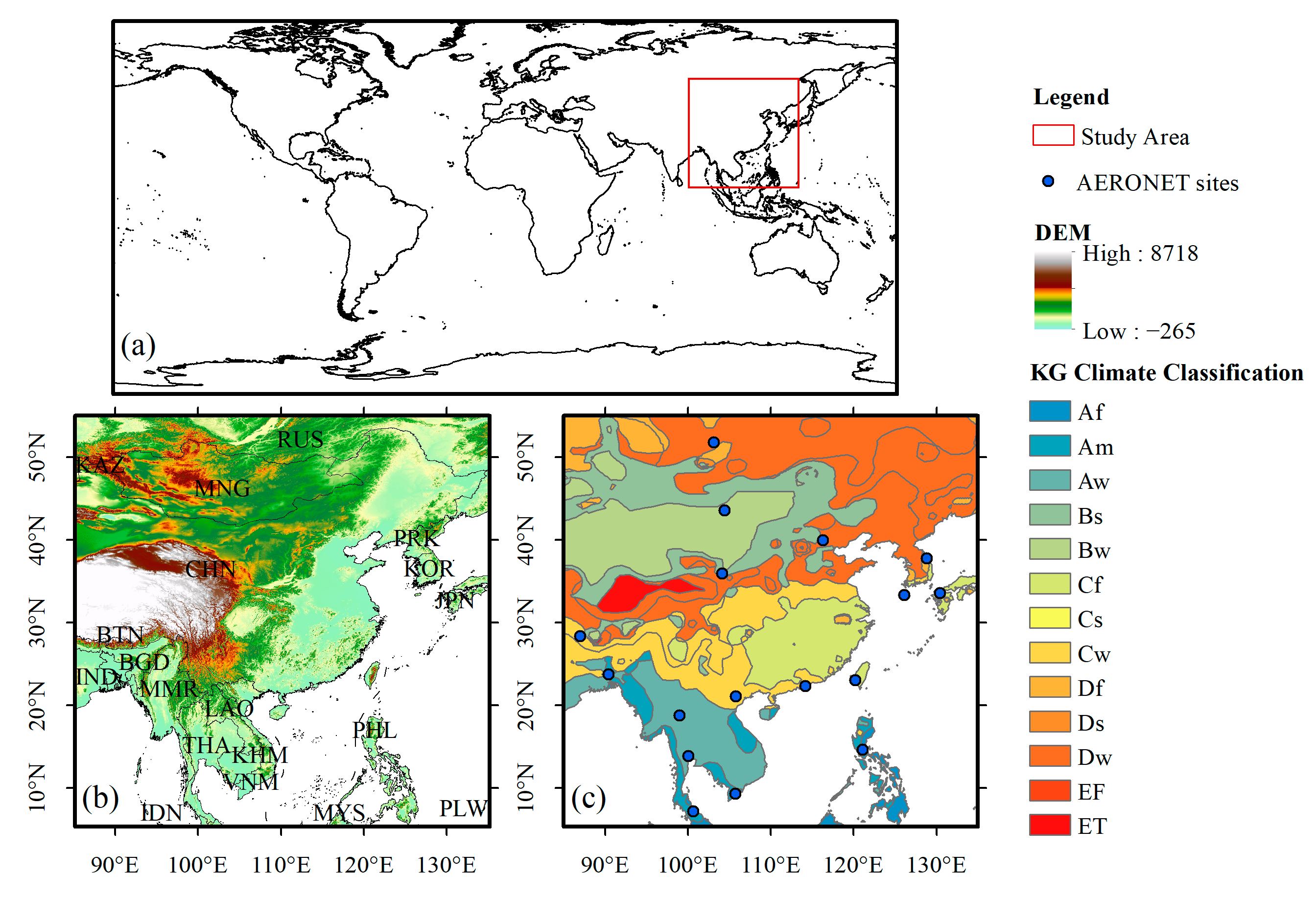
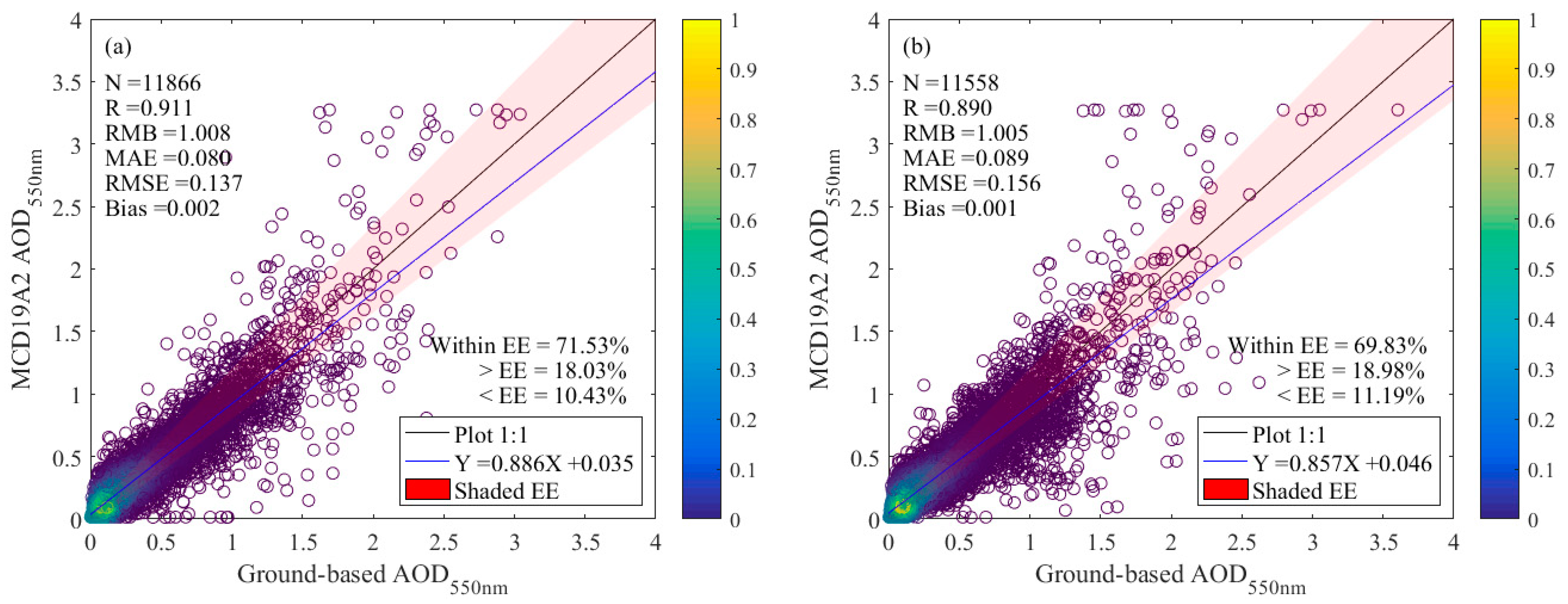
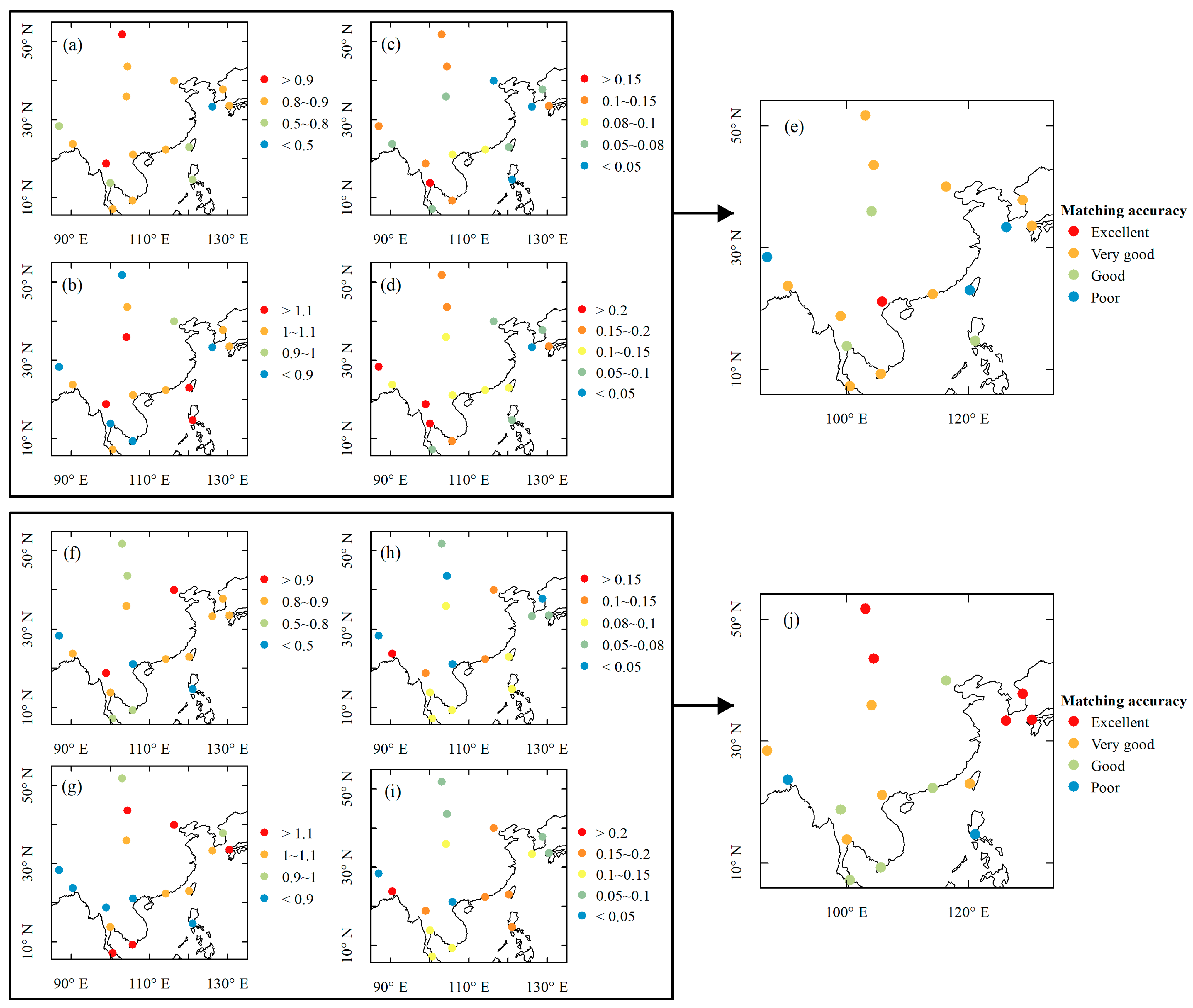


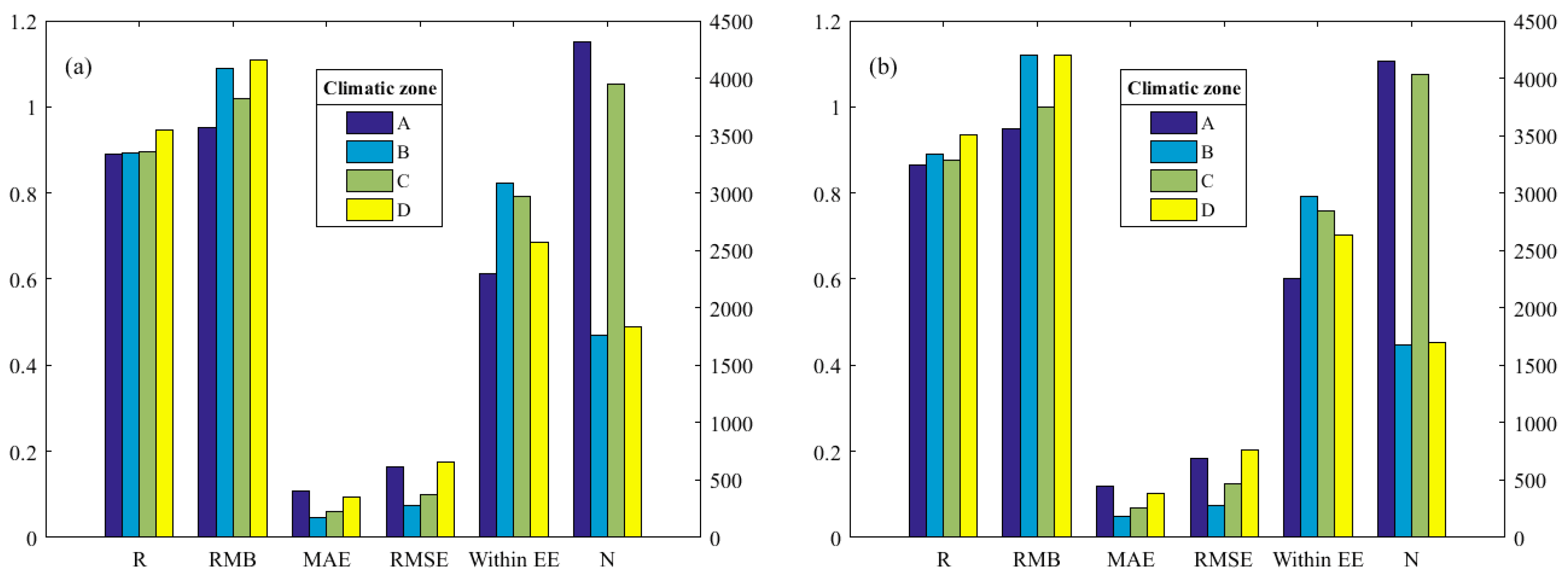
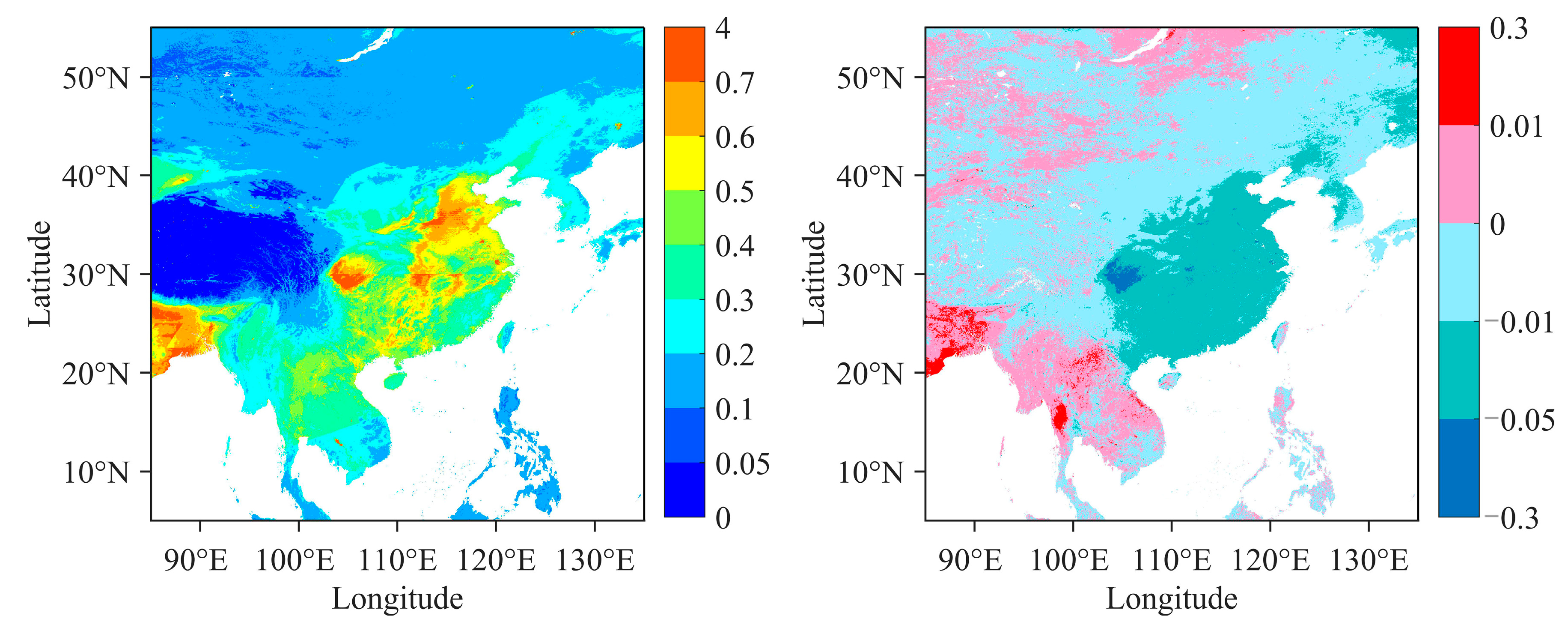
| Name of Station | Longitude (°E) | Latitude (°N) | Time Span | Elevation (m) |
|---|---|---|---|---|
| Bac_Lieu | 105.73 | 9.28 | 2011–2019 | <50 |
| Chen-Kung_Univ | 120.205 | 22.993 | 2011–2020 | |
| Dhaka_University | 90.398 | 23.728 | 2012–2020 | |
| Fukuoka | 130.475 | 33.524 | 2012–2020 | |
| Gangneung_WNU | 128.867 | 37.771 | 2012–2020 | |
| Gosan_SNU | 126.162 | 33.292 | 2011–2016 | |
| Hong_Kong_PolyU | 114.18 | 22.303 | 2011–2017 | |
| NGHIA_DO | 105.8 | 21.048 | 2011–2016, 2018–2019 | |
| Silpakorn_Univ | 100.041 | 13.819 | 2011–2020 | |
| Songkhla_Met_Sta | 100.605 | 7.184 | 2011–2020 | |
| Beijing-CAMS | 116.317 | 39.933 | 2012–2020 | 50–200 |
| Manila_Observatory | 121.078 | 14.635 | 2011–2020 | |
| Chiang_Mai_Met_Sta | 98.972 | 18.771 | 2011–2020 | 200–500 |
| Irkutsk | 103.087 | 51.8 | 2011–2020 | 500–1000 |
| Dalanzadgad | 104.419 | 43.577 | 2011–2020 | 1000–2000 |
| SACOL | 104.137 | 35.946 | 2011–2013 | |
| QOMS_CAS | 86.948 | 28.365 | 2011–2017 | >2000 |
| Climatic Zone | Climatic Type | Climate Subtype | Characteristic |
|---|---|---|---|
| A: Equatorial zone | Tcold ≥ 18 | ||
| Af (Tropical rainforest climate) | Pdry ≥ 60 mm | ||
| Aw (Tropical open forest climate) | Pdry ≤ 60 mm and Pdry ≥ (100-MAP/25) mm | ||
| Am (Tropical monsoon climate) | Pdry ≤ 60 mm and Pdry ≤ (100-MAP/25) mm | ||
| B: Arid zone | MAP < 10 Pth | ||
| BS (Steppe climate) | MAP ≥ 5 Pth | ||
| BW (Desert climate) | MAP < 5 Pth | ||
| h k | MAT ≥ 18 °C MAT < 18 °C | ||
| C: Warm zone | Thot > 10 °C and 0 °C < Tcold < 18 °C | ||
| Cs (Dry summer and warm climate) | Psdry < 40 mm and Psdry < Pwwet/3 | ||
| Cw (Dry and warm climate in winter) | Pwdry < Pswet/10 | ||
| Cf (Normally humid and warm climate) | Neither Cw nor Cf | ||
| a b c | Thot ≥ 22 °C Thot < 22 °C and count (Tmon > 10 °C) ≥ 4 Tcold ≥ −38 °C and count (Tmon > 10 °C) < 4 | ||
| D: Cold temperate zone | Thot > 10 °C and Tcold ≤ 0 °C | ||
| Ds (Subarctic continental climate) | Psdry < 40 mm and Psdary < Pwwet/3 | ||
| Dw (Sub-frigid monsoon climate) | Pwdry < Pswet/10 | ||
| Df (Normally humid and cold temperature climate) | Neither Ds nor Dw | ||
| a b c d | Thot ≥ 22 °C Thot < 22 °C and count (Tmon > 10 °C) ≥ 4 Tcold ≥ −38 °C and count (Tmon > 10 °C) < 4 Tcold < −38 °C | ||
| E: Polar zone | Thot < 10 °C | ||
| ET (Tundra climate) | Thot > 0 °C | ||
| EF (Frost climate) | Thot ≤ 0 °C |
| R | RMB | MAE | RMSE | Reclassification |
|---|---|---|---|---|
| <0.5 | <0.8/>1.2 | >0.15 | >0.2 | 1 |
| 0.5–0.8 | 0.8–0.9/1.1–1.2 | 0.1–0.15 | 0.15–0.2 | 2 |
| 0.8–0.9 | 0.9–1.1 | 0.08–0.1 | 0.1–0.15 | 3 |
| >0.9 | 0.05–0.08 | 0.05–0.1 | 4 | |
| <0.05 | <0.05 | 5 | ||
| Summation of reclassification | Accuracy | |||
| >12 | Excellent | |||
| 9–12 | Very good | |||
| 7–9 | Good | |||
| <7 | Poor | |||
Publisher’s Note: MDPI stays neutral with regard to jurisdictional claims in published maps and institutional affiliations. |
© 2022 by the authors. Licensee MDPI, Basel, Switzerland. This article is an open access article distributed under the terms and conditions of the Creative Commons Attribution (CC BY) license (https://creativecommons.org/licenses/by/4.0/).
Share and Cite
Wang, P.; Tang, Q.; Zhu, Y.; Zheng, K.; Liang, T.; Yu, Q.; He, Y. Validation and Analysis of MAIAC AOD Aerosol Products in East Asia from 2011 to 2020. Remote Sens. 2022, 14, 5735. https://doi.org/10.3390/rs14225735
Wang P, Tang Q, Zhu Y, Zheng K, Liang T, Yu Q, He Y. Validation and Analysis of MAIAC AOD Aerosol Products in East Asia from 2011 to 2020. Remote Sensing. 2022; 14(22):5735. https://doi.org/10.3390/rs14225735
Chicago/Turabian StyleWang, Ping, Qingxin Tang, Yuxin Zhu, Ke Zheng, Tianquan Liang, Quanzhou Yu, and Yaqian He. 2022. "Validation and Analysis of MAIAC AOD Aerosol Products in East Asia from 2011 to 2020" Remote Sensing 14, no. 22: 5735. https://doi.org/10.3390/rs14225735








